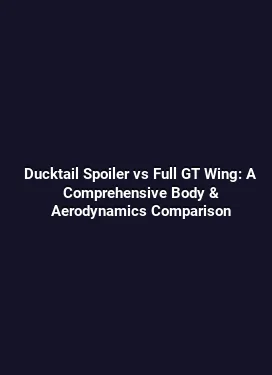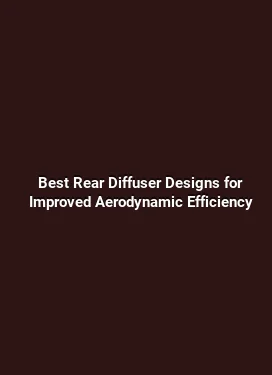Best Aero Package for Time Attack Cars: Complete Setup Guide
In the world of time attack racing, aerodynamic excellence translates directly into lap time reductions. The most effective aero package is not a collection of flashy parts but a carefully balanced system that harmonizes downforce, drag, cooling, and mechanical grip. This guide dives into the core components, testing methods, and practical tuning steps that help high-performance machines slice through air with minimal resistance and maximum stability. Rather than relying on surface-level descriptions, the discussion focuses on the interplay of aerodynamics with chassis dynamics, tire behavior, and track conditions—providing actionable insights for engineers, builders, and serious enthusiasts.
Foundational Principles of Aerodynamics for Time Attack

Effective aero starts with a clear understanding of how air interacts with a vehicle at racing speeds. Downforce increases grip and cornering capability, but it often comes with a price: higher drag that can limit top speed. Achieving an optimal aerodynamic balance involves mapping the pressure distribution across the vehicle’s surfaces, managing flow separation at the trailing edges, and ensuring that high-velocity air remains attached to critical surfaces through carefully designed shaping and edges.
One core concept is aerodynamic efficiency, which describes the force produced per unit of drag. A focused effort on improving efficiency means nudging downforce toward the wheel contact patches where it matters most, while trimming drag in regions that contribute little to stability. This balance is particularly crucial in time attack, where the objective is to minimize lap times on a fixed layout, rather than maximizing straight-line speed alone. The approach combines surface geometry, edge treatments, and the strategic use of underbody channels to guide the air in a predictable manner.
In practice, teams measure pressure distribution using pressure taps and wind tunnel data, then translate findings into practical geometry changes. Modern aero development also embraces computational fluid dynamics (CFD) to explore thousands of configurations quickly before validating the most promising ideas on track. By integrating data-driven insights with real-world testing, a time attack aero package evolves toward a stable, high-efficiency configuration that remains robust across temperature swings and tire wear patterns.
Airflow, Stability, and Thermal Management

Airflow management is not limited to generating downforce. It also directs cooling air to radiators, brakes, and powertrain components, ensuring performance is not compromised by overheating. A well-designed front intake, side ducting, and rear cooling channels can maintain consistent engine and brake temperatures even when aero forces push the car toward higher speeds. The challenge is to separate the thermal paths from regions where the air is accelerating to create lift, so cooling remains reliable without sacrificing aerodynamic efficiency.
Stability at high speed hinges on predictable wake behavior and minimal yaw-induced instability. Subtle tweaks to endplates, wing mounting angles, and venting can dramatically alter the wake structure, reducing buffeting and ensuring the car tracks straight through high-speed corners. In time attack, where precision and repeatability are paramount, stability becomes a critical performance metric that guides every design choice.
Front End Architecture: Downforce, Flow, and Cooling Synergy
The front end shapes the initial interaction between the car and the atmosphere. A well-integrated front aero package channels air to critical regions while minimizing disturbing disturbances that would propagate downstream. The primary elements include the front splitter, dive planes or canards, and carefully shaped air intake inlets. Each component serves multiple purposes: generating downforce on the nose, managing lift at higher angles, and delivering clean, low-turbulence air to the radiator and intercoolers.
Splitters extend the lower surface forward to increase piston-like pressure at the front axle, pressing the car down toward the road. Dive planes create additional vortices that energize the boundary layer and help keep the flow attached along the fenders, reducing cornering moment and improving steering feel at the limit. The design philosophy emphasizes a balanced distribution of downforce between the nose and the mid-section, preventing excessive load transfer that would demand stiffer suspension and degrade corner entry response.
Canards and Vortex Generators
Canards and vortex generators are employed to manipulate the air before it reaches the main body, producing beneficial wake structures that enhance rear downforce without significantly increasing drag. When sized and positioned correctly, these features generate robust, self-cleaning vortices that re-energize boundary layers along the hood and fenders. The geometry of canards—such as corner radius, edge sharpness, and their interaction with the splitter—needs careful calibration to avoid over-stressing the front-end load or causing undesirable lift at certain yaw angles.
For practical use, engineers often start with a baseline configuration that mirrors the track’s characteristics: a longer, flatter splitter for stability on long straights, combined with a pair of smaller canards to sharpen turn-in without destabilizing the car in mid-c corner. Iterative adjustments are then made via tunnel testing and on-track runs to refine angles of attack and the resulting vortex strength.
Underbody and Diffuser: Harnessing Ground Effect and Flow Separation Control
The underbody and diffuser play a pivotal role in converting high-speed air into downforce while minimizing drag. The goal is to maintain a smooth, low-pressure region under the car that effectively “sucks” the chassis toward the track. A well-tuned undertray reduces lift without creating large suction gradients that could destabilize suspension tuning or accentuate ride-height sensitivity. In time attack, where every millisecond counts, the efficiency of underbody channels often yields a noticeable difference in corner exit speed and mid-corner stability.
The diffuser manages the transition of high-velocity air from under the car into the free stream. A properly contoured diffuser re-energizes the boundary layer and reduces flow separation at the rear, contributing to higher downforce with a tolerable drag penalty. The complexity lies in ensuring the diffuser remains effective across a range of ride heights, because aero balance shifts as the car compresses under load or raises due to mechanical adjustments. Edge treatment, corner exit geometry, and the alignment of the diffuser with the rear wing all interact to sculpt the rear wake for maximum stability.
Rear Wing and Endplates
The rear wing is the final arbiter of rear downforce, yaw stability, and top speed potential. Its angle of attack, width, and endplate geometry determine how strongly the rear axle is pressed into the pavement and how much neutral or negative lift is generated near the tail. Endplates prevent wing tip vortices from spilling over the sides, reducing induced drag and improving efficiency. The endplates also influence the overall aerodynamic balance between front and rear, so changes here must be counterbalanced with adjustments to the front end and underbody.
In practice, teams adjust wing height and incidence to optimize straight-line speed while preserving cornering grip and directional stability. On tighter tracks, a lower wing with a broader endplate footprint can yield better balance, while on fast, sweeping circuits, a higher wing combined with refined endplates may improve high-speed cornering performance. The use of adjustable mounting hardware enables rapid iteration during test days and event weekends.
Side Aerodynamics and Cooling Airflow Management
Side aerodynamics influence boundary layer behavior along the car’s side surfaces, fender vents, and door lines. Properly managed side flow reduces interference drag and helps channel air toward the intercooler, radiator, and brake ducts. A clean separation line along the door seam and a well-shaped rocker panel area work together to minimize air separation that can cause late-stage turbulence near the rear wheel well. Side skirts contribute to reducing underside aerodynamic leakage and can improve the effective width of the vehicle’s downforce envelope without adding substantial drag.
Cooling air pathways are as critical as the aerodynamic surfaces themselves. Efficient ducting to radiators and brakes keeps temperatures stable, preserving tire performance and braking efficiency under sustained high-speed loads. Inadequate cooling can force the driver to compromise aero performance to prevent overheating, which undermines the overall setup. The design objective is to create low-pressure regions that pull air through the system while not introducing excessive drag or interference with the front and underbody aerodynamics.
Door Vents and Side Skirts: Practical Tuning Tools
Door vents and side skirts are practical tuning tools that influence both cooling and aero balance. Strategically placed vents reduce heat buildup in critical components and can help manage the stagnation pressure near the cockpit, which in turn affects driver comfort and air intake efficiency. Side skirts further seal the underbody region, decreasing leakage and making the rear wing more effective. The key is to avoid creating new flow separation zones or increasing drag by promoting unnecessary turbulence along the car’s midpoint.
Real-world tuning involves measuring underbody pressure and front-to-rear pressure differentials during static and dynamic tests. Adjustments are made to vent sizes, duct routing, and skirt geometry to achieve a stable pressure gradient, ensuring that the aero package behaves predictably at the limit rather than chasing transient gusts of air or track-induced wind shifts.
Materials, Assembly, and Weight Considerations
Choosing materials and mounting strategies that maximize rigidity while minimizing weight is fundamental. Composite surfaces, aluminum or carbon fiber panels, and carefully positioned fasteners influence aero performance by maintaining consistent geometry under load. Flex under load can alter the intended air paths, so stiffness and mounting compatibility with the suspension and bodywork must be harmonized. Weight distribution also affects aero performance indirectly, through ride height and dynamic load transfer, so every aero element must be evaluated for its impact on the car’s mass center and inertia properties.
Durability is another essential factor. Aero components are subjected to high loads, track debris, and thermal cycling. A durable design includes robust edge protection, protective coatings, and attention to thermal expansion to prevent misalignment that could degrade aerodynamic performance. Field testing across multiple events builds confidence that the selected materials and assembly methods retain their geometry under real-world conditions.
Maintenance and Inspection Routines
Regular inspection of aero components is vital. Cracks, delamination, or deformation can drastically alter airflow and handling. A structured maintenance routine includes pre-event checks for mounting hardware integrity, wear indicators on endplates and edges, and verification that gaps and seals remain within target tolerances. Documenting changes with photos and measurements supports consistent development across sessions and helps team members interpret performance shifts between runs.
Testing Methods: Wind Tunnel, CFD, and On-Track Validation
True aero optimization relies on a combination of wind tunnel testing, CFD simulations, and on-track validation. Wind tunnels provide controlled, repeatable conditions to quantify lift, drag, and downforce across a range of speeds and yaw angles. CFD offers rapid exploration of design variants, enabling the creation of parametric families for components like splitters, diffusers, and wings. On-track validation confirms that lab results translate to real-world performance on the track’s surface, which is subject to temperature, wind, and track geometry variations.
A practical development workflow starts with a reliable baseline configuration, collected through a combination of pressure measurements and dynamic testing. Subsequent iterations focus on components with the most significant impact on lap time, such as the front splitter geometry and diffuser efficiency. Data-driven decision-making ensures that aero changes deliver tangible gains in acceleration, corner exit speed, and braking stability without introducing new compromise points elsewhere in the car.
Track-specific factors drive the customization of aero packages. A time attack machine designed for a fast, open-track layout may prioritize higher top speed with careful drag management, while a circuit with numerous tight turns might emphasize downforce and stability at corner entry. The most effective solutions are rarely universal; they are tuned to the exact characteristics of the car, track conditions, and the driver’s preferred balance.
Data-Driven Iteration and Real-World Adaptation
In practice, teams maintain a data loop that compares predicted performance from simulations with actual lap times and telemetry. If a predicted improvement in corner speed does not translate into faster laps, aero changes are reevaluated with a focus on the root cause—whether it is flow separation, under- or over- downforce, or increased drag that offsets gains. This disciplined approach prevents the aero package from drifting toward high-drag configurations that offer little real-world advantage on a given track layout.
Adaptive strategies, such as adjustable endplates, wing flaps, and removable underbody panels, allow the aero package to be optimized between practice, qualification, and event conditions. The ability to tailor the aero balance to the track’s character is a decisive advantage in time attack competition, where minor gains in aero efficiency can translate into meaningful differences in sector times and overall lap averages.
Practical Guidelines for Building a Time Attack Aero Package
Begin with a robust baseline that emphasizes reliability, balanced downforce, and predictable handling. Focus on the front splitter geometry and the diffuser’s taper as primary levers for initial improvements. Use available wind tunnel and CFD data to inform the sizing of canards and endplates, then validate improvements with on-track testing under consistent conditions. Maintain a disciplined approach to weight and stiffness, ensuring aero gains do not come at the expense of chassis integrity or brake performance.
When tuning, track the relationship between speed, steering input, and the car’s response through high-speed sections and slow corners. The goal is to reduce the car’s tendency to push or oversteer under high-lift conditions while preserving the ability to exploit high-speed stability. Document every modification with detailed notes and data, enabling repeatability and easy rollback if a change yields undesirable results.
Safety, Compliance, and Track Etiquette
Aero components must comply with event regulations and track rules. Ensure that all elements are securely mounted, do not pose a risk to other competitors, and remain within allowed dimensions. Routine checks before events help prevent last-minute failures that could jeopardize a race weekend. A well-maintained aero package not only performs better but also reduces the chance of component failure during critical laps.
In summary, the best aero package for time attack cars is a carefully tuned system that balances downforce, drag, cooling, and stability. It leverages a combination of front-end shaping, underbody optimization, and rear-end efficiency, validated through a rigorous testing program and adapted to track-specific demands. This approach yields consistent improvements in lap times, driver confidence, and overall performance on race day.






